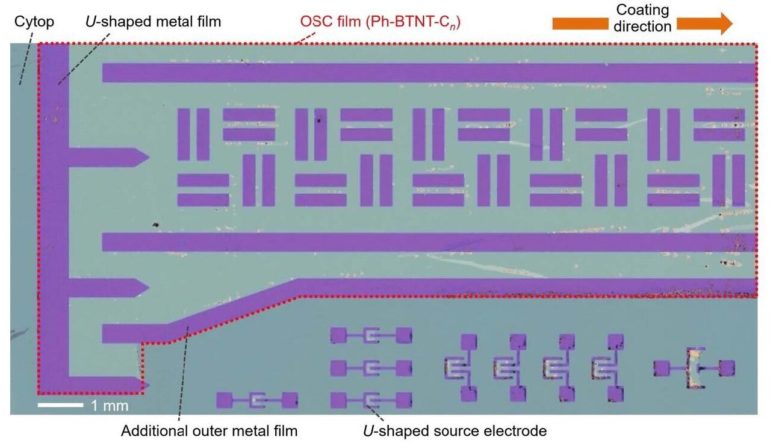For around 10 years, smartphones and computer screens have been based on a display technology composed of so-called thin film transistors. These are inorganic transistors that require very little power, and they have proven themselves capable, given their widespread adoption. But they have limits that researchers have been busy trying to overcome.
“We explore new ways to improve upon thin film transistors, such as new designs or new methods of manufacture,” said Gyo Kitahara, a Ph.D. student from the Department of Applied Physics. “Organic thin film transistors, for example, have a bright future in LCD screen devices. Compared to the inorganic kind currently used, we expect the organic kind to be useful in low-cost, large-area, lightweight and wearable electronic products, especially by using printing-based production technologies.”
The idea of organic thin film transistors is not new, but the ability to print such devices, which would allow for a design revolution, has eluded industry and academics until now. Professor Tatsuo Hasegawa of the Department of Applied Physics, Kitahara and their team came up with a way to print organic semiconductor films, the basis of these transistors, on a special surface that is highly solution-repellent, or lyophobic. This means ordinarily, the surface would repel the materials required to print the structure of the transistor, which seems counterintuitive. But lyophobic surfaces are responsible for creating transistor structures that are finely tuned for high performance. So how did the researchers overcome their repellent nature?
“We made use of a fluidic property you probably see every time you wash your hands with soap,” said Kitahara. “Soap bubbles can hold a shape by lowering the surface tension of liquid. We presume that the soap-film mechanism should be effective for formation of a thin liquid layer on lyophobic surfaces in spite of the repellent forces. Solid semiconductor films can be formed and grown via the formation of thin liquid layers during the printing processes.”
With this innovation, other researchers can build on the team’s findings and find ways to scale this method up. With a proliferation of large, flexible or wearable devices, Hasegawa’s team dreams of seeing a convergence between the real world and virtual world in ways we’ve never seen before.
“After having experimented by trial and error, we eventually found that the use of a special U-shaped metal-film pattern seems to be effective for uniform film growth thanks to the way it creates a thin liquid layer on lyophobic surfaces,” said Kitahara. “We anticipated the results beforehand to some extent, but the success of these findings was finally demonstrated and obtained after overcoming several difficulties, which brought great pleasure and happiness to me.”
Researchers develop new printing method for mass production of thin film transistors
More information:
Meniscus-controlled printing of single-crystal interfaces showing extremely sharp switching transistor operation. Science Advances, DOI: 10.1126/sciadv.abc8847
Provided by
University of Tokyo
Citation:
Printing high-speed low-power organic transistors (2020, October 7)
retrieved 11 October 2020
from https://techxplore.com/news/2020-10-high-speed-low-power-transistors.html
This document is subject to copyright. Apart from any fair dealing for the purpose of private study or research, no
part may be reproduced without the written permission. The content is provided for information purposes only.



